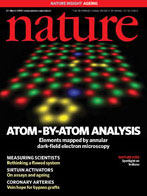专题:Nature系列

欧洲科学家发现,细菌能够在无光照的情况下用自己制造的氧气来分解甲烷气体。该发现表明在植物首次出现之前细菌就已开始制造氧气,补上了地球演化过程中“缺失的一环”。相关研究成果发表在3月25日的《自然》杂志上。
甲烷是一种化学性质相当稳定的气体,跟强酸、强碱等一般不起反应。理论上,真核生物在厌氧条件下能够利用硝酸盐氧化甲烷,但此前,利用这种反应的生物无论是在自然环境中还是在实验室中都没有被发现,微生物氧化甲烷作用仅被认为在氧气和硫酸盐条件下才能发生。直到2006年,荷兰奈梅亨拉德伯德大学的马克施特鲁斯与合作者在对一个微生物群落的研究中才发现,该微生物群落在完全无氧条件下能利用硝酸盐脱硝作用氧化甲烷。
而现在,该大学的研究人员和法国以及德国科学家组成的一个国际研究小组进一步研究发现,在没有现成氧气源,也没有光照的情况下,细菌可以将亚硝酸盐分解为一氧化氮和氧气,然后用生成的氧气来分解甲烷获取能量。
因为相应的微生物的生长极为缓慢,且在微生物群落中只有少量存在,荷兰研究人员不得不用基因分析的最新方法――宏基因组方法来对这些微生物进行研究。他们先分离出水样中的基因片段,然后进行基因的测序和重构。
令研究人员惊讶的是,完整的基因组序列分析表明,还原亚硝酸盐缺少特定的基因,而且这种细菌对氧气有依赖。实验室的实验数据与基因组数据有矛盾。为探明细菌究竟是如何在亚硝酸盐的帮助下从稳定的甲烷氧化中获取能量的,德国马克斯-普朗克海洋微生物学研究所的科学家亦加入了研究工作。
通过微型传感器和质谱分析,德国科学家证实了矛盾的真实性。综合实验结果和基因组数据,科学家们认为只有当细菌使用特殊途径生产出氧气来氧化甲烷才是合适的解释。不过证明氧气的生成是一个漫长的任务,经过一年多的努力,凯瑟琳埃特维希博士终于成功得到了实验性的证据:这种微生物可从两个亚硝酸盐分子中释放出一氧化氮和氧气,甲烷可随后被氧化。
此前,科学家们一致认为,地球上最早的产氧光养生物是海藻和蓝藻。它们在大气层从无氧到有氧的转化过程中起了关键作用。而现在,最新的研究成果让科学家发现了一个新机制的线索。细菌在第一种植物出现在地球上之前就已经存在,细菌在地球演变过程中的作用将补上地球演化中“缺失的一环”。同时,由于亚硝酸盐通过化肥的使用而在淡水农业土壤中大量存在,新的研究结果也可为肥料在甲烷循环中的利用提供契机。(生物谷Bioon.com)
生物谷推荐原文出处:
Nature doi:10.1038/nature08883
Nitrite-driven anaerobic methane oxidation by oxygenic bacteria
Katharina F. Ettwig1,10, Margaret K. Butler1,10,11, Denis Le Paslier2,3,4, Eric Pelletier2,3,4, Sophie Mangenot2, Marcel M. M. Kuypers5, Frank Schreiber5, Bas E. Dutilh6, Johannes Zedelius5, Dirk de Beer5, Jolein Gloerich7, Hans J. C. T. Wessels7, Theo van Alen1, Francisca Luesken1, Ming L. Wu1, Katinka T. van de Pas-Schoonen1, Huub J. M. Op den Camp1, Eva M. Janssen-Megens8, Kees-Jan Francoijs8, Henk Stunnenberg8, Jean Weissenbach2,3,4, Mike S. M. Jetten1 " Marc Strous1,5,9
Only three biological pathways are known to produce oxygen: photosynthesis, chlorate respiration and the detoxification of reactive oxygen species. Here we present evidence for a fourth pathway, possibly of considerable geochemical and evolutionary importance. The pathway was discovered after metagenomic sequencing of an enrichment culture that couples anaerobic oxidation of methane with the reduction of nitrite to dinitrogen. The complete genome of the dominant bacterium, named ‘Candidatus Methylomirabilis oxyfera’, was assembled. This apparently anaerobic, denitrifying bacterium encoded, transcribed and expressed the well-established aerobic pathway for methane oxidation, whereas it lacked known genes for dinitrogen production. Subsequent isotopic labelling indicated that ‘M. oxyfera’ bypassed the denitrification intermediate nitrous oxide by the conversion of two nitric oxide molecules to dinitrogen and oxygen, which was used to oxidize methane. These results extend our understanding of hydrocarbon degradation under anoxic conditions and explain the biochemical mechanism of a poorly understood freshwater methane sink. Because nitrogen oxides were already present on early Earth, our finding opens up the possibility that oxygen was available to microbial metabolism before the evolution of oxygenic photosynthesis.







